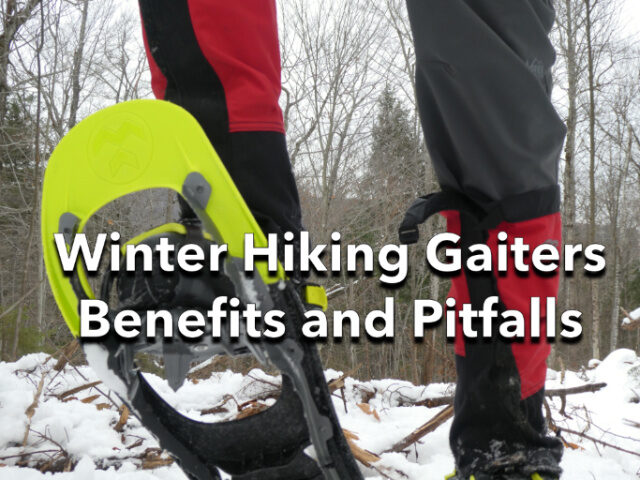
Winter hiking gaiters, namely high gaiters, are an important part of a winter hiking clothing layering system but they definitely have some pluses and minuses. While the benefits still outweigh the negatives, this is a piece of gear that could really stand to be reimagined by some small company looking to make a name for itself.
What are High Gaiters?
High gaiters are a winter clothing layer, usually waterproof, that covers the top of your footwear and pants, extending up your leg to just below the knee. They prevent snow from sticking to your pants or socks, melting, and making them wet. They also block the wind and trap body heat, so your feet and calves stay warmer.
High gaiters run from the toe box of your boots where they hook onto the laces, up to just below your knee, and have a durable strap that runs under the sole of your boots to keep them from riding up. Most models can be put on when you already have your boots on and wrap around your shins and calves, securing in front with a long strip of velcro or a water-resistant zipper. There’s also usually an adjustable strap or elastic cord at the top to tighten around the top of your calf to prevent the gaiter from sliding down your leg.

The bottom of a high gaiter is usually made with heavy-duty nylon for protection against self-inflicted crampon strikes. This can occur when you are wearing full mountaineering crampons, you get tired, and your foot placements become less accurate. But fewer and fewer winter hikers use full crampons anymore, opting for winter traction aids like Hillsound Trail Crampons or Kahtoola Microspikes where there is little risk of injury from their smaller traction points.
The upper portion of a high gaiter is often made with a waterproof/breathable material to help vent water vapor since your calves will sweat. When present, this waterproof/breathable section is easily torn because it’s much thinner than the bottom of the gaiter. Less expensive gaiters, like those sold on Amazon from no-name brands, often don’t have waterproof/breathable uppers and are solid nylon from top to bottom.

High Gaiter Pitfalls
There are a number of usability issues with high gaiters that are worth knowing about, even though there’s not much you can do to avoid their pitfalls. There are a very limited number of high gaiters available, so you often have to make do with what you can find.
Perspiration – While high gaiters will prevent snow from making your pant legs and socks wet, they can trap a lot of body heat causing your lower legs to perspire, soaking your socks and lower pant legs in the process. This is often exacerbated by wearing 400g insulated winter hiking boots that run over the ankle and up the leg. As long as you keep moving it’s not a huge issue, because you will stay warm, but it’s not ideal. This happens even if your gaiters have waterproof/breathable uppers. In other words, the breathability is awful.
Sizing – Gaiters are sized by shoe sizes without consideration for the size of your calves. If you have big feet but average-sized calves, your gaiters will be too large and will have a tendency to fall down around your ankles when worn. This is not ideal because it can become a trip hazard, especially when wearing full crampons.
Bottom Strap – If you damage or lose the bottom strap that runs under the soles of your boots, it can be very difficult to repair. It depends on the gaiter, but many manufacturers use bottom straps that cannot be replaced at home and require an industrial sewing machine to be replaced.
Top Strap – The best type of top strap to hold the gaiter above the calf is an elastic cord with a cordlock. It’s pretty rare, however. Most gaiters have a webbing strap/buckle to hold the gaiter up, but it’s difficult to get tight enough to keep the gaiters from falling down around your ankles.
SectionHiker is reader-supported. We independently research, test, and rate the best products. We only make money if you purchase a product through our affiliate links. Help us continue to test and write unsponsored and independent gear reviews, beginner FAQs, and free hiking guides.

